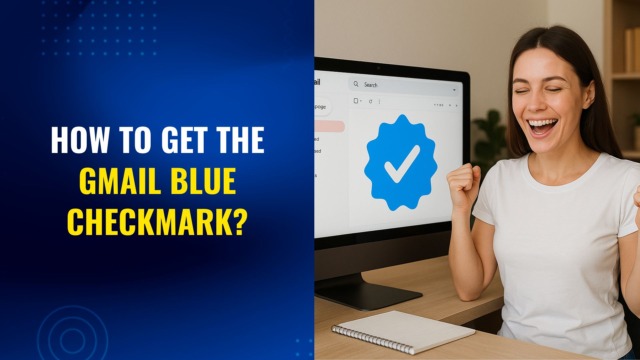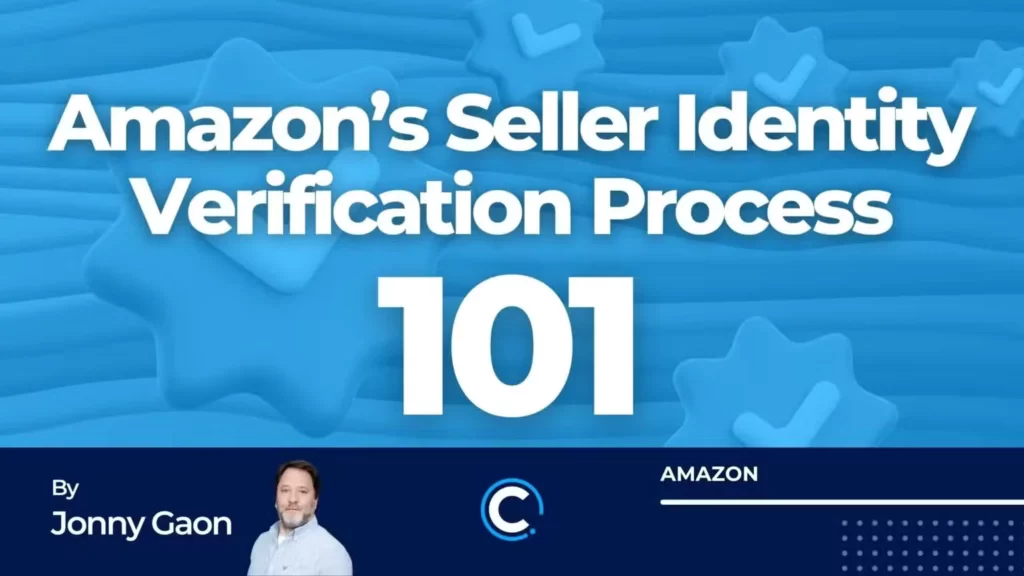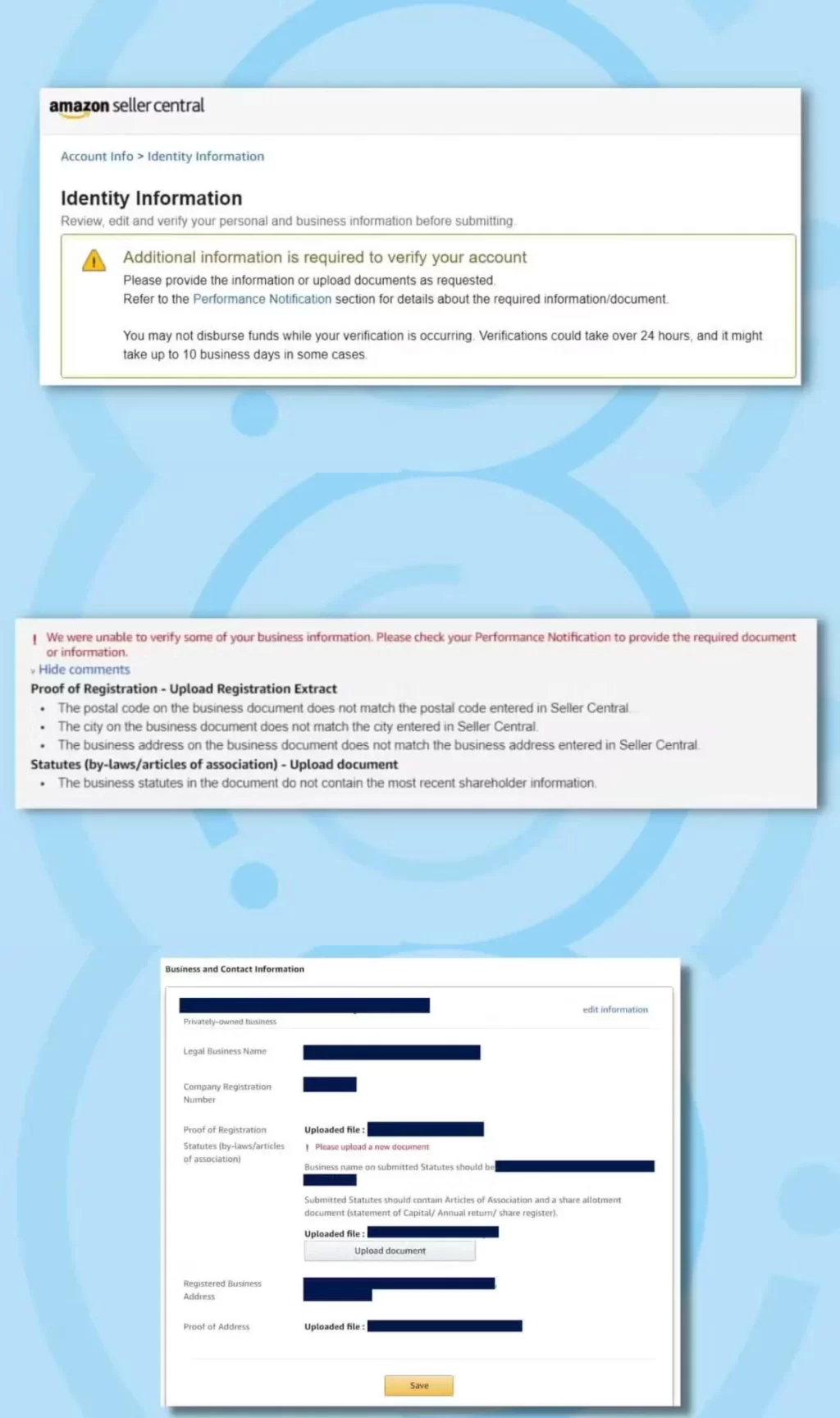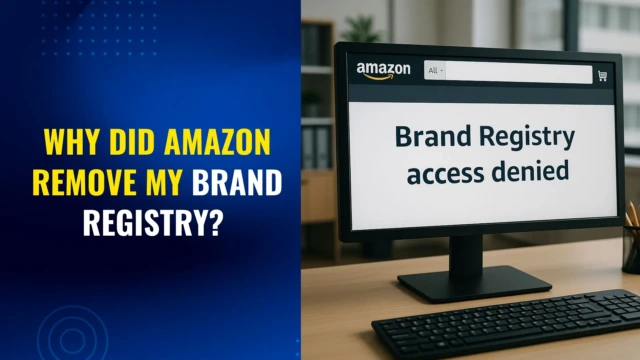
Book a FREE 15-minute consultation with an expert – Book Now
Amazon’s seller identity verification process 101 – Sounds simple but is often famously frustrating!

The Amazon Seller Verification (SIV) is exactly what you would expect – a process whereby Amazon confirms the identities of the businesses and individuals who sell on the platform. You may think that this would be a simple, quick, and painless process, however, the reality is that many sellers find themselves stuck in an endless loop of template rejections and frustration. While there are distinct differences between the verifications process in the US and EU, in our experience, preparing well in advance, and understanding how the process works, can go a long way to reducing potential issues.
Why does Amazon need to verify my seller information?
After registering a new seller account, verification must be passed before you receive permission to sell on the platform. However, secondary verification for existing seller accounts, also known as “re-verification”, may be required from time to time for accounts that are active and selling normally.
How does the Amazon seller verification process look like?
The exact process can differ depending on the marketplace (US vs EU, for example) and your business structure, but generally Amazon require you to upload a government issued ID document, usually a passport or driver’s license, and proof of address, such as a bank or credit card statement, or utility bill. If your legal entity is a company, additional documents may be required, such as a Business License or Registration or Articles of Association. The biggest difference between the US and EU/UK verifications process is that for EU/UK accounts, Amazon may require you to submit an ownership structure diagram, and also to provide share allotment declarations and documentation, concerning the “beneficial owners” – the people who ultimately own or control your business or who own more than 25% of shares.
Amazon provides detailed information regarding their requirements, and we strongly recommend that you review the various “Amazon Pay” help pages for the marketplace in question (including the additional links in the menu on the left of the page):
–Amazon US
-Amazon EU/UK
The Amazon seller verification process serves to protect!
The Amazon seller identity verification process serves to protect both buyers and sellers and is an important part of Amazon’s obligation to prevent money laundering, the sale of counterfeit products, and other illegal activity, and to keep “bad-actors” off the platform. Periodic verification may also be initiated by Amazon to remain compliant with their legal obligations in certain countries.
During verification for a new account, the account will initially be set as inactive, however Amazon will sometimes open the account after the first round of documents have been provided, even when more information is required. Amazon will provide full details regarding the additional information and documentation that is needed, and let you know the timeframe for submission. Generally, for routine verification of an already active account, you will be allowed to continue selling and will be given 30/60 days to provide the requested documentation (however Amazon will not disburse funds to you until verification is complete).
Here is an example of what the Amazon message regarding additional documentation may look like:

———-
Update 07.10.2023
INFORM act verification for sellers on Amazon’s US marketplace
The “INFORM Consumers Act” was recently passed by the US Congress and came into effect on June 27, 2023. The purpose of the Act is to increase transparency to online transactions and to deter criminals from acquiring stolen, counterfeit, or unsafe items and selling them through the defined marketplaces. Online marketplaces are now required to collect, verify, and disclose certain information about their sellers to the authorities and are also required to suspend the accounts of “high-volume” third party sellers who do not provide this information. A great number of sellers on Amazon.com will have received notifications regarding INFORM Act verification in the last 1-2 months.
Note also that Amazon are now required to certify that your information is current annually, and the timeframe for providing information and documentation may be short, so keeping your information current on Amazon and having the correct documentation at hand is even more important.
For more information, see Amazon’s “About the INFORM Consumers Act” Guidelines.
———-
Amazon’s new video verifications process
The verification procedure has evolved over the years, and new processes are trialed or introduced periodically, such as video verification or mailing a physical card to a seller’s business address with a code to input in Seller Central, to verify that the address is correct. While most sellers will still likely encounter the standard Seller Central verification process at some point, Amazon do seem to be rolling out their new video verifications system to more and more sellers.
Video verification, or the “identity verification video call” in Amazon’s language, involves providing your identity documents while on a video call with an Amazon agent. Amazon states that their system uses “forgery detection, facial recognition, and liveness detection technology to quickly verify the authenticity of government-issued identity documents and whether they match the individual applying to sell”.
If the video option is available for you, the process and requirements will be as described below:
- During the registration process, and after you have uploaded your documents in Seller Central, you will be asked to schedule a call from a list of date and time slots that Amazon provides (you may also have the option to request a call right away and will be placed in a queue for the next available agent).
- You should prepare for the call as if it was a business meeting: make sure you are in a well-lit, quiet room, ensure you have a strong and reliable internet connection, and be dressed suitably for a professional meeting, etc…
- Amazon will need to see the original, physical documents that you have uploaded to Seller Central, including your ID document, and you can check which documents to have ready by visiting the document upload page that you completed during registration.
- You can join the call from any device that has a front-facing camera and microphone, such as a laptop, tablet, or cell phone, however be sure to review all the information provided, as there are a number of technical requirements, such as using the Safari browser if on an iOS device, and Chrome, for all other devices.
- The verification call itself is fairly straightforward – the agent will simply ask you to hold up your documents to the camera, front and back – and the call usually lasts for 15-20 minutes in total. Most of this time will be spent waiting for Amazon to verify the documents you have shown.
- Amazon will usually notify you by email within 2-3 days if you have successfully completed the process.
In addition, Amazon may require you to schedule a video verification call when your existing account has been deactivated or is facing possible deactivation following account health issues, such as repeated IP violations or inauthenticity complaints. This may also be required when Amazon is considering releasing funds that have been held after an account has been deactivated, or after an account-level velocity review.
In such cases, Amazon will inform you that they need to “verify information related to your identity and the authenticity of your supply chain”, as well as the documents requested in a regular verification call. The general process is the same, but you will also have to show Amazon your physical invoices.
What triggers the verification process?
As mentioned, Amazon may initiate routine reverification in certain marketplaces, in order to meet their legal requirements in certain locations, however, there are some situations and events that are known to trigger verification. These include:
- When an account that has been inactive for some time wishes to start selling again.
- When changes are made to the critical account information (such as legal entity or bank/credit card methods, etc…). Note: if these changes are made correctly, verification can often be avoided, but not always.
- When an account is under review due to “unusual” changes in account activity, such as sudden increased sales velocity.
- When certain disbursement benchmarks are approaching. For example, in Europe/UK, verification may be triggered when you approach 15,000 Euro or GBP in disbursements.
- More recently, we have seen verifications that were seemingly triggered by account health issues, such as after receiving multiple or repeat IP complaints.
While many of the triggers for Amazon verification or Amazon reverification can’t be easily avoided, planning for a possible verification request in advance can make the whole process much smoother.
How can I prepare for the Amazon verification in advance?
Preparing for verification in advance and being aware of the process and requirements are the best ways to avoid many of the most common pitfalls, certainly, when opening a new account.
Most issues are the result of entering information into Amazon that cannot be backed up by documentation. Therefore, it is crucial that all information entered in your account is exactly as seen on your documents. Amazon uses algorithms to compare the details on your documents to the information entered in Seller Central, and even seemingly irrelevant differences can cause your documents to be rejected. Your company name, for example, should be entered exactly as written on your business registration documents, even down to capitalization, as these are the documents that Amazon will request during verification. Your name should be entered exactly as recorded in your passport, driving license, or other government issued ID – if your middle name is on these documents, then provide your full name to Amazon. Even using abbreviations like “St.” for “street” in your address can cause a discrepancy. It is hard to stress how important it is to only add information to your account that can be exactly backed up by your documents.
If there are discrepancies between the information in Seller Central and your documents, you may have to have new documents issued.
In the same way, your various documents should match each other. For example, providing an ID document with an old address, and a utility bill for your current address will most likely lead to the documents being rejected.
Amazon also require specific documents to have been issued within set timeframes, such as the previous 90 days for a utility bill, for example, so that they can be confident that the information is current and accurate.
While not specifically related to verification, you should also be absolutely sure that none of the information or documentation you provide has ever been used in another seller account, even if the account was never approved and was never activated. Providing information or documentation that is already in Amazon’s records will likely cause the account to be connected/related to another account and can lead to Amazon refusing to allow you to open your new account.
Also note that changes to your personal situation (eg: divorce) or business, may lead to a situation where you are no longer able to provide Amazon with documents that match your previously entered information. It is best to avoid such a scenario by keeping your account information up to date and making the necessary changes at the time. However, such changes to critical account information should be made very carefully, as the changes themselves can trigger verification. While triggering verification can’t always be avoided, we recommend consulting with a specialist who can take you through this process and greatly reduce the chances of this happening.
Overall, taking care that your information is entered correctly right from the start, and ensuring that your verification documents are easily accessible, current and exactly match the information Amazon has, can help avoid most of the most common issues.
What are Amazon’s requirements for verification documents?
Amazon provides extensive information in their help pages, and we recommend that you read through these carefully. As well as the basic requirements for documents, such as document type and date, etc… there are also many format and technical requirements that must be met for your documents to be accepted. Even if your documents are perfect, sending them in the wrong file format, or using the wrong file size, can lead to them being rejected. Below is a list of some of Amazon’s requirements, though there are too many to include here:
- First and foremost, it should go without saying that all documents must be genuine, accurate and unaltered. Do not add or amend anything in any of your documents, including highlighting, annotations, etc… If Amazon suspect, rightly or wrongly, that you have provided tampered, unoriginal, or amended documents, your account will likely be immediately deactivated. Appealing such decisions can be extremely difficult and the chances of a successful outcome are low.
- Documents must be in one of Amazon’s approved languages (unless there is a translation on the document itself – for example, most passports will have each section in the language of the country issuing the passport, as well as in English, which is acceptable. Certain documents may require an officially notarized translation.
- The documents should be either scanned to pdf or sent as a high-quality photo – screenshots are not approved. The document must be flat, not angled, without glare or shadow and show all edges.
- Documents should be provided in full (if you are providing a 3-page bank statement, provide all 3 pages, not just the seemingly more important first page). If there is anything contained on the back of a printed document, such as a bank statement, you should provide images of both sides of each page.
- Certain documents, such as bank or credit card statements, need to have been issued in the last 90 days. Amazon will provide specific information in their notification or email.
- Also take note of the maximum file size limits, the file name rules, file type and format specifications – for example, images of your passport should show multiple pages, merged into one file, rather than as pages submitted separately.
- Amazon may provide different options for some document types depending on the country you are located in or where your business was registered.
Unfortunately, however, it is the case that Amazon will sometimes reject documents without providing a clear reason, despite you being certain that you have sent everything that Amazon requested.
What to do if my documents are rejected by Amazon?
First of all, take a deep breath and carefully read Amazon’s response and any notes that may be provided in the document upload section of your Account Info page and might help you with the Amazon seller identity verification problem. Often, Amazon will let you know which documents were rejected, and may provide a reason or instructions regarding what they need to receive, and this information can be easily missed. While Amazon are not always specific, this information can at least provide you with a place to start.
Below is an example of the information and instructions Amazon may provide in the “Account Info” page of Seller Central:

However, even if your documents seem to match Amazon’s requirements to the last detail, they may still be rejected without any reason being provided. Sometimes waiting and submitting them again can result in them being accepted, however it is not usually a good idea to continuously submit the same documents that have been previously rejected.
In summary:
Understanding the Amazon verification process before registering your new seller account, and only adding information to Amazon that can be exactly backed up by your documentation, can help avoid much frustration down the line.
Making sure that your documents are readily available, current, and exactly match the information you provided Amazon (whether you have just opened a new account or are a 10-year seller who is being re-verified), will go a long way to ensuring a quick and successful verification.
If you are sure that everything you have provided meets Amazon’s guidelines, but your documents are still being rejected, you should contact a specialist, who can review your account and documents and advise you regarding the best way to proceed. Note that even in this case, it may take weeks or even months to pass verification, so patience is needed.
Legal Disclaimer: The articles published on our platform are for informational purposes only and do not constitute legal advice in any form. They are not intended to be a substitute for professional legal counsel. For any legal matters, it is essential to consult with us or a qualified attorney who can provide advice tailored to your specific situation. Reliance on any information provided in these articles is solely at your own risk.
Amazon Brand Registry – Discover for Free if You’re Eligible
Increase Your Chance of Getting a
Trademark to 96%
Subscribe to Our Newsletter
Sign up to receive valuable information on E-Commerce and intellectual property

